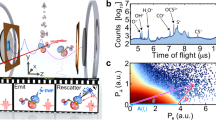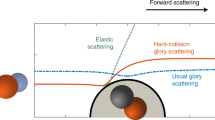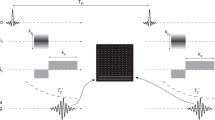Abstract
Stereodynamics describes how the vector properties of molecules, such as the directions in which they move and the axes about which they rotate, affect the probabilities (or cross-sections) of specific processes or transitions that occur on collision. The main aspects of stereodynamics in inelastic atom–molecule collisions can often be understood from classical considerations, in which the particles are represented by billiard-ball-like hard objects. In a quantum picture, however, the collision is described in terms of matter waves, which can also scatter into the region of the geometrical shadow of the object and reveal detailed information on the pure quantum-mechanical contribution to the stereodynamics. Here we present measurements of irregular diffraction patterns for NO radicals colliding with rare-gas atoms that can be explained by the analytical Fraunhofer model. They reveal a hitherto overlooked dependence on (or ‘propensity rule’ for) the magnetic quantum number m of the molecules, and a previously unrecognized type of quantum stereodynamics that has no classical analogue or interpretation.
This is a preview of subscription content, access via your institution
Access options
Subscribe to this journal
Receive 12 print issues and online access
$259.00 per year
only $21.58 per issue
Buy this article
- Purchase on Springer Link
- Instant access to full article PDF
Prices may be subject to local taxes which are calculated during checkout





Similar content being viewed by others
References
van de Meerakker, S. Y. T., Bethlem, H. L., Vanhaecke, N. & Meijer, G. Manipulation and control of molecular beams. Chem. Rev. 112, 4828–4878 (2012).
Heck, A. J. R. & Chandler, D. W. Imaging techniques for the study of chemical reaction dynamics. Annu. Rev. Phys. Chem. 46, 335–372 (1995).
Ashfold, M. N. R. et al. Imaging the dynamics of gas phase reactions. Phys. Chem. Chem. Phys. 8, 26–53 (2006).
Aoiz, F. J. et al. A new perspective: imaging the stereochemistry of molecular collisions. Phys. Chem. Chem. Phys. 17, 30210–30228 (2015).
Wang, F., Liu, K. & Rakitzis, T. P. Revealing the stereospecific chemistry of the reaction of Cl with aligned CHD3 (v1 = 1). Nat. Chem. 4, 636–641 (2012).
Orr-Ewing, A. J. & Zare, R. N. Orientation and alignment of reaction products. Annu. Rev. Phys. Chem. 45, 315–366 (1994).
Herschbach, D. Chemical stereodynamics: retrospect and prospect. Eur. Phys. J. D 38, 3–13 (2006).
Costen, M. L., Marinakis, S. & McKendrick, K. G. Do vectors point the way to understanding energy transfer in molecular collisions? Chem. Soc. Rev. 37, 732–743 (2008).
McCaffery, A. J., Proctor, M. J. & Whitaker, B. J. Rotational energy transfer: polarization and scaling. Annu. Rev. Phys. Chem. 37, 223–244 (1986).
Aquilanti, V., Cavalli, S., Grossi, G. & Anderson, R. W. Stereodirected states in molecular dynamics: a discrete basis representation for the quantum mechanical scattering matrix. J. Phys. Chem. 95, 8184–8193 (1991).
Aoiz, F. J., Herrero, V. J., Sáez-Rábanos, V. & Verdasco, J. E. Classical stereodynamics in Ar + NO inelastic collisions. Phys. Chem. Chem. Phys. 6, 4407–4415 (2004).
Brouard, M., Chadwick, H., Eyles, C. J., Aoiz, F. J. & Kłos, J. The k–j–j′ vector correlation in inelastic and reactive scattering. J. Chem. Phys. 135, 084305 (2011).
Jambrina, P. G., Kłos, J., Aoiz, F. J. & de Miranda, M. P. New findings regarding the NO angular momentum orientation in Ar–NO(2Π1/2) collisions. Phys. Chem. Chem. Phys. 14, 9826–9837 (2012).
Balint-Kurti, G. G. & Vasyutinskii, O. S. Vector correlation analysis for inelastic and reactive collisions between partners possessing spin and orbital angular momentum. J. Phys. Chem. A 113, 14281–14290 (2009).
Lorenz, K. T. et al. Direct measurement of the preferred sense of NO rotation after collision with argon. Science 293, 2063–2066 (2001).
Paterson, G., Costen, M. L. & McKendrick, K. G. Collisional depolarization of rotational angular momentum: what are the observables and how can they be measured? Mol. Phys. 109, 2565–2585 (2011).
Paterson, G., Costen, M. L. & McKendrick, K. G. Collisional depolarisation of rotational angular momentum: influence of the potential energy surface on the collision dynamics? Int. Rev. Phys. Chem. 31, 69–109 (2012).
Chadwick, H., Brouard, M., Perkins, T. & Aoiz, F. J. Collisional depolarisation in electronically excited radicals. Int. Rev. Phys. Chem. 33, 79–123 (2014).
Nichols, B. et al. Steric effects and quantum interference in the inelastic scattering of NO(X) + Ar. Chem. Sci. 6, 2202–2210 (2015).
Stolte, S. Aiming the molecular arrow. Nature 353, 391–392 (1991).
Case, D. A. & Herschbach, D. R. Statistical theory of angular momentum polarization in chemical reactions. Mol. Phys. 30, 1537–1564 (1975).
Case, D. A., McClelland, G. M. & Herschbach, D. R. Angular momentum polarization in molecular collisions: classical and quantum theory for measurements using resonance fluorescence. Mol. Phys. 35, 541–573 (1978).
Barnwell, J. D., Loeser, J. G. & Herschbach, D. R. Angular correlations in chemical reactions. Statistical theory for four-vector correlations. J. Phys. Chem. 87, 2781–2786 (1983).
Chandler, D. W. & Stolte, S. in Gas Phase Molecular Reaction and Photodissociation Dynamics (eds Lin, K. C. & Kleiber, P. D.) 1–63 (Transworld Research Network, 2007).
Schiffman, A. & Chandler, D. W. Experimental measurements of state-resolved, rotationally inelastic energy transfer. Int. Rev. Phys. Chem. 14, 371–420 (1995).
Kohguchi, H. & Suzuki, T. State-to-state rotational inelastic scattering of free radicals. Annu. Rep. Prog. Chem. C 98, 421–449 (2002).
Schreel, K., Schleipen, J., Eppink, A. & ter Meulen, J. J. State-to-state cross sections for rotational excitation of OH by collisions with He and Ar. J. Chem. Phys. 99, 8713–8722 (1993).
Kohguchi, H., Suzuki, T. & Alexander, M. H. Fully state-resolved differential cross sections for the inelastic scattering of the open-shell NO molecule by Ar. Science 294, 832–834 (2001).
Khare, V., Kouri, D. J. & Hoffman, D. K. On j z-preserving propensities in molecular collisions. I. Quantal coupled states and classical impulsive approximations. J. Chem. Phys. 74, 2275–2286 (1981).
Khare, V., Kouri, D. J. & Hoffman, D. K. On a j z-preserving propensity in molecular collisions. II. Close-coupling study of state-to-state differential cross sections. J. Chem. Phys. 76, 4493–4501 (1982).
Brouard, M. et al. Rotational alignment effects in NO(X) + Ar inelastic collisions: a theoretical study. J. Chem. Phys. 138, 104309 (2013).
Cline, J. I., Lorenz, K. T., Wade, E. A., Barr, J. W. & Chandler, D. W. Ion imaging measurement of collision-induced rotational alignment in Ar–NO scattering. J. Chem. Phys. 115, 6277–6280 (2001).
Brouard, M., Hornung, B. & Aoiz, F. J. Origin of collision-induced molecular orientation. Phys. Rev. Lett. 111, 183202 (2013).
Steill, J. D. et al. Rotational alignment of NO (A2∑+) from collisions with Ne. J. Phys. Chem. A 117, 8163–8174 (2013).
Orlikowski, T. & Alexander, M. H. Lack of M-preserving propensities in rotationally inelastic collisions of NO(X2Π1/2). J. Chem. Phys. 80, 4133–4136 (1984).
Faubel, M. The ‘Fraunhofer theory’ of rotational inelastic scattering of He on small molecules. J. Chem. Phys. 81, 5559–5569 (1984).
Lemeshko, M. & Friedrich, B. An analytic model of rotationally inelastic collisions of polar molecules in electric fields. J. Chem. Phys. 129, 024301 (2008).
Lemeshko, M., Jambrina, P. G., de Miranda, M. P. & Friedrich, B. Communications: when diffraction rules the stereodynamics of rotationally inelastic collisions. J. Chem. Phys. 132, 161102 (2010).
Lemeshko, M. & Friedrich, B. An analytic model of the stereodynamics of rotationally inelastic molecular collisions. Phys. Chem. Chem. Phys. 12, 1038–1041 (2010).
Onvlee, J., Vogels, S. N., van der Avoird, A., Groenenboom, G. C. & van de Meerakker, S. Y. T. Resolving rainbows with superimposed diffraction oscillations in NO + rare gas scattering: experiment and theory. New J. Phys. 17, 055019 (2015).
Eppink, A. T. J. B. & Parker, D. H. Velocity map imaging of ions and electrons using electrostatic lenses: application in photoelectron and photofragment ion imaging of molecular oxygen. Rev. Sci. Instrum. 68, 3477–3484 (1997).
Chandler, D. W. & Houston, P. L. Two-dimensional imaging of state-selected photodissociation products detected by multiphoton ionization. J. Chem. Phys. 87, 1445–1447 (1987).
Scharfenberg, L. et al. Scattering of Stark-decelerated OH radicals with rare-gas atoms. Eur. Phys. J. D 65, 189–198 (2011).
Kłos, J., Chałasiński, G., Berry, M. T., Bukowski, R. & Cybulski, S. M. Ab initio potential-energy surface for the He(1S) + NO(X2Π) interaction and bound rovibrational states. J. Chem. Phys. 112, 2195–2203 (2000).
Alexander, M. H. A new, fully ab initio investigation of the NO (X2Π)Ar system. I. Potential energy surfaces and inelastic scattering. J. Chem. Phys. 111, 7426–7434 (1999).
Wen, B., Meyer, H., Kłos, J. & Alexander, M. H. Joint experimental–theoretical investigation of the lower bound states of the NO(X2Π)–Kr complex. J. Phys. Chem. A 113, 7366–7375 (2009).
Kłos, J. et al. Ab initio studies of the interaction potential for the Xe-NO(X2Π) van der Waals complex: bound states and fully quantum and quasi-classical scattering. J. Chem. Phys. 137, 014312 (2012).
Yan, B. et al. A new high intensity and short-pulse molecular beam valve. Rev. Sci. Instrum. 84, 023102 (2013).
Vogels, S. N. et al. High-resolution imaging of velocity-controlled molecular collisions using counterpropagating beams. Phys. Rev. Lett. 113, 263202 (2014).
Dribinski, V., Ossadtchi, A., Mandelshtam, V. A. & Reisler, H. Reconstruction of Abel-transformable images: the Gaussian basis-set expansion Abel transform method. Rev. Sci. Instrum. 73, 2634–2642 (2002).
Aoiz, F. J., Verdasco, J. E., Herrero, V. J., Sáez Rábanos, V. & Alexander, M. A. Attractive and repulsive interactions in the inelastic scattering of NO by Ar: a comparison between classical trajectory and close-coupling quantum mechanical results. J. Chem. Phys. 119, 5860–5866 (2003).
Acknowledgements
The research leading to these results has received funding from the European Research Council (ERC) under the European Union's Seventh Framework Programme (FP7/2007-2013)/ERC grant agreement 335646 MOLBIL. This work is part of the research program of the Foundation for Fundamental Research on Matter (FOM), which is financially supported by the Netherlands Organization for Scientific Research (NWO). S.Y.T.v.d.M. acknowledges support from NWO via a VIDI and a TOP grant. The support of the UK EPSRC (to M.B. via Programme Grant EP/L005913/1) is gratefully acknowledged. S.D.S.G and M.B thank Cambio Ltd and P. Dean for generous support. The authors thank M. Lemeshko for carefully reading the manuscript and for valuable suggestions. Moreover, we thank L. Gerritsen, C. Berkhout, P. Claus, N. Janssen and A. van Roij for expert technical support.
Author information
Authors and Affiliations
Contributions
The project was conceived by S.Y.T.v.d.M. and M.B. The experiments were carried out by S.N.V. Data analysis and simulations were performed by J.O. and S.N.V. Scattering calculations were performed by J.O. using a scattering program developed by G.C.G. and A.v.d.A. The interpretation of the data using the Fraunhofer model was performed by J.O., A.v.d.A., G.C.G. and S.Y.T.v.d.M. with input from S.D.S.G., T.A., T.K., B.N. and M.B. The explanation of vector correlations based on the Fraunhofer model and the Huygens principle was developed by G.C.G., A.v.d.A., T.K., J.O. and S.Y.T.v.d.M. The ESA calculations were performed by T.K. The kinematic apse model calculations were performed by S.D.S.G. The paper was written by J.O. and S.Y.T.v.d.M. with contributions from all the authors.
Corresponding authors
Ethics declarations
Competing interests
The authors declare no competing financial interests.
Supplementary information
Supplementary information
Supplementary information (PDF 1145 kb)
Rights and permissions
About this article
Cite this article
Onvlee, J., Gordon, S., Vogels, S. et al. Imaging quantum stereodynamics through Fraunhofer scattering of NO radicals with rare-gas atoms. Nature Chem 9, 226–233 (2017). https://doi.org/10.1038/nchem.2640
Received:
Accepted:
Published:
Issue Date:
DOI: https://doi.org/10.1038/nchem.2640
This article is cited by
-
Glory scattering in deeply inelastic molecular collisions
Nature Chemistry (2022)
-
Anisotropic dynamics of resonant scattering between a pair of cold aligned diatoms
Nature Chemistry (2022)
-
Stopping molecular rotation using coherent ultra-low-energy magnetic manipulations
Nature Communications (2022)
-
Ultimate control in chemistry
Nature Chemistry (2021)
-
Molecular collisions: From near-cold to ultra-cold
Frontiers of Physics (2021)



